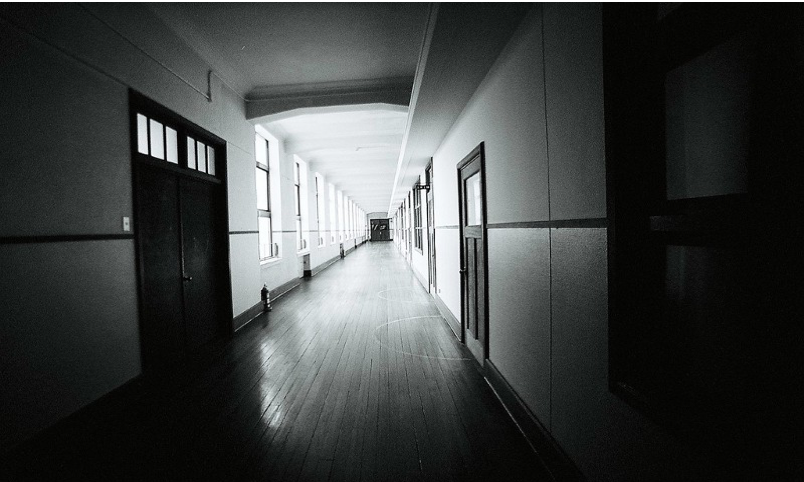Comments‘WE PRETEND’, FIRST PERSON ACCOUNT--After Parkland, I remember moving a pair of large scissors from my desk to the podium in the front of my classroom.
It wasn’t a conscious strategy I formulated — like how James Bond scatters an arsenal around his home so he is ready for anything. Instead, it was the illusion of action I was pursuing— the idea that somehow I could trick myself into believing my classroom was safer if I could grab a pair of scissors quickly regardless of where I was in the room. That was the same day I first saw a student bring a Kevlar-lined backpack to school. At our staff meeting, we learned about our new fire alarm policy — when the fire alarm goes off, shelter in place until someone comes on the intercom to give further instruction.
This is what the illusion of action looks like. While grabbing some books from my closet last week, I subconsciously took a mental note of how many kids I could fit inside it. Sometimes while my kids are working, I look at my door and wonder how many of our flimsy desks it would take to barricade it — and how many seconds it would take for someone to wade through them — and which students I would ask in those few seconds to rush the door with me to give us all the best chance. And then I blink back to reality, always trapped in this macabre dichotomy between teaching social studies to kids one moment and pondering those seconds of terror the next.
I am inundated with headlines like “10 Dead, 10 Hurt, and Many Unsurprised”, and “2018 Has Been Deadlier For Schoolchildren than Service Members”, and I browse through them casually in between classes while laughing children cascade through the halls around me. On Friday, some of our seniors organized “Protest Day”, and I saw one girl’s poster had the names of the Parkland victims on it. I told her there had been another shooting, in Texas, and she said, “How many this time?”
Sometimes after school I meet up with teachers, and together we tell stories and we laugh and we rant about “the system” like the annoying idealists we are. And on some of these nights, after hours of conversations about curriculum and debates over pedagogy, someone slips in the simple question: “How often do you think about shootings?” The last time I heard this question asked, another teacher quietly responded, “Every day.” And then the question floated away on the May breeze and we were back to ordering drinks and enjoying wings and planning our summers.
We have become so accustomed to spasms of random violence, accustomed to lock-down drills and body counts and “How many this time?” and the names of high schools trending on twitter. Mass murder is so common in America that we cannot keep them straight in our own minds. We confuse and conflate different shootings until they dissolve into one cloud, hanging over us constantly. We know that they are real, but they always seem to be a part of another universe; a universe where lawmakers do nothing; a universe in need of a profound moral reckoning; a universe where children don’t always come home from school.
The illusion of action looks like teaching children to move around the room as much as possible, not because it will save their lives, but because it will take an extra second longer to kill them, giving the class next door an extra second to run. The illusion of action looks like the obscene storm that emerges after each shooting; the storm where liberals literally criticize the people who say they are “praying for the families”; the storm where conservatives continue to treat the second amendment like scripture and not what it really is. It is an American tradition for citizens to sprint to their ideological corners, demonize the other, and then forget. Eventually the memory dissolves completely, wafting up into the hazy cloud where our national consciousness keeps all of the other mass shootings.
Under the shadow of that cloud, we continue to settle for the illusion of action. We pretend that, in the only society on earth with this problem, we have done all we can. We know that somewhere in this country an ugly idea is forming in the mind of a young boy. He feels entitled to the respect of other men and to the attention of women, and when he gets neither he will fantasize about raging against the entire system that made him feel so powerless. He is dreaming about claiming power in the most real sense; to squeeze his finger over here and watch someone die over there. We have given him easy access to assault rifles. We have left him without a reliable mental health system. We have continued to cultivate a culture that dehumanizes and schools that depersonalize.
We know what this framework will allow. Nothing shocks us. It could happen in a theater or a church or an elementary school, and no matter where it happens, we will not be surprised. But we must find a way to carry on, so we pretend that our half-hearted measures and our barricaded classrooms and our prayers count as action.
As we continue to live in this illusion, that ugly idea is taking shape, forming borders, consuming that boy.
(Matt Bockenfeld is a High School History Teacher - Writer. Follow him @MrBTheTeach. He posts at Medium.com … where this perspective originated.)
-cw
















